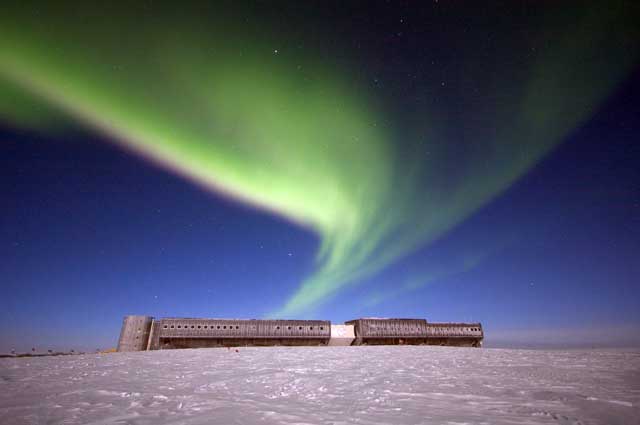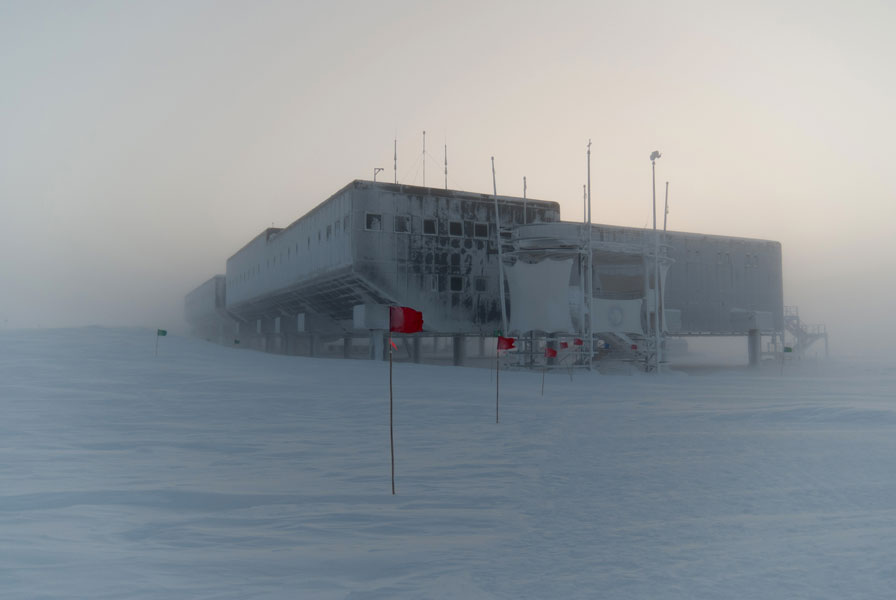Amundsen-Scott South Pole Station
Amundsen-Scott South Pole Station (US) lies close to the geographic South Pole at an elevation of 2835 m. The station is constructed on ice that is ~2700 meters (9000 feet) thick, and it moves with the ice sheet towards the Weddell Sea at a rate of approximately 10 meters per year.
The first station at the South Pole was established in 1956 during the International Geophysical Year (IGY). A permanent station has operated continuously since, although with several major upgrades. The most recent was dedicated in 2008, when the distinctive geodesic dome was replaced by the modern elevated building that forms the main station today.
While precipitation at the Pole is low, wind-blown snow accumulation is a perennial problem and without clearance structures can become buried. The first station, now referred to as ‘Old Pole’, eventually was crushed by the weight of snow and ice and had to be abandoned deep under the surface. More recently, the geodesic dome was also being buried although the decision was taken to dismantle and remove it before it became engulfed by ice.
The replacement station is of a more aerodynamic design and is elevated above ground level in order to minimize snow accumulation. In addition to dining and sleeping accommodation for up to around 170 people, the facilities include a computer laboratory, meeting rooms, lounges, a gym, medical surgery, emergency power plant, and a hydroponic greenhouse where fresh vegetables are grown. The station has a floor area of about 65,000 square feet.
During winter, about 50 scientists and support personnel live at the station to run experiments and maintain facilities, while in the summer this increases up to a maximum of around 170. The station is completely isolated between mid-February and late-October, as air and overland support to the Pole cannot be undertaken because conditions are so extreme.
Other structures at the Pole include the Atmospheric Research Observatory (ARO), located approximately 500 m from the elevated station, workshops, air operations facilities, and fuel tanks. The IceCube Neutrino Observatory is situated around 500 m from the elevated station in the Dark Sector. All permanent facilities at the Pole have been constructed by the United States Antarctic Program. Temporary camp facilities are erected in the summer by non-governmental expeditions visiting the South Pole, and these are located around 750 m from the elevated station in an area which does not conflict with science or support operations. The layout of Amundsen-Scott South Pole Station is shown in Map 4.
South Pole Traverse (SPoT)
Until 2008, all supplies to Amundsen-Scott South Pole Station were delivered on LC-130 aircraft. To reduce the cost and increase the efficiency and reliability of transporting fuel and materials to South Pole Station, USAP established an overland traverse route from McMurdo Station to the South Pole. The traverse route is approximately 1,030 miles long and took several years of route-finding to prove and to mitigate areas with crevassing. This route is traveled by the South Pole Traverse (SPoT), a tractor train that hauls supplies and fuel using specialized sleds. SPoT tractors ascend more than 9,300 feet along the route to Amundsen-Scott South Pole Station. On average, it takes 52 days for the round trip from McMurdo to Pole and back.
It is estimated that each north-south trip of the traverse saves approximately 33 LC-130 flights and has a lower carbon footprint relative to the use of aircraft. An innovation for SPoT was the development of a fuel transport system that consists of four polyethylene sheets attached to a spreader bar. Each sheet carries two 3,000-gallon fuel bladders.







